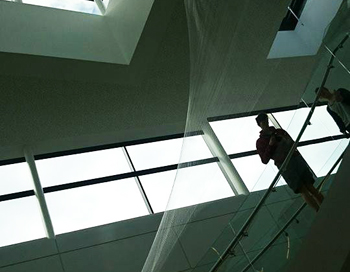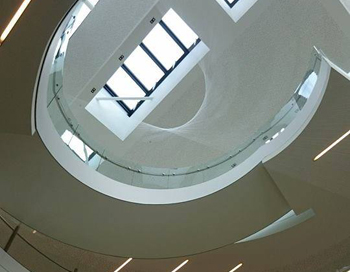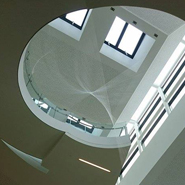Posted 05 May 2015
Physics and art students exhibit collaborative work
Two UCD students and a student of the National College of Art and Design have showcased a unique artwork that they created through their collaborative work in the fields of art and science in an exhibition at UCD.
The elegant and imaginative work entitled ‘Fermat’s Piano’ was made from individual strands of fishing line that bent and twisted upwards to trace the contours of the spiral staircase on the third and fourth floors of UCD’s O’Brien Science Research Centre building.
The work was exhibited as part of the Tunneling Art & Science Exhibition – an exhibition that showcases the collaborative work of arts and science students.
Depending on the light that shone through the large panes of glass in the O’Brien building and the position from which the work was observed, viewers could see different shadows, contours and patterns on the strands of closely-threaded fishing line each time they looked at the artwork.
The piece was named after Fermat – the 17th century physicist who proposed a principle governing the path that a ray of light can take. The students also felt that the rhythm and structure of the piece resembled that of a grand piano.The artwork was created by UCD students, Mauro de Luca (third year Theoretical Physics), David Rogers (third year Physics with Astronomy and Space Science) and NCAD student Michele Hetherington (second year Fine Art Print).
They used 5km of fishing line, 15m of wooden dowels and 28 retort stand clamps to create the piece.
The students created the work as part of the Tunneling Art & Science Module – an elective module that brings students of Fine Art at the NCAD and students of UCD Science together in collaborative work.
Describing the idea behind the piece, Mauro de Luca said the students focused on the simple theories behind geometrical optics and how light travels in straight lines.
“The seeds of ‘Fermat’s Piano’were sown by projecting interference patterns made by overlapping concentric rings on the walls of the studio. Then we experimented with shadows produced by shining light on patterns made from string,” he said.“The visibility of the lines varies with the observer’s point of view, thus, slowly revealing light’s presence. The curvature of the lines echoes how space can bend light. The convergence of light is also suggested in the apparent intersection of the lines in our piece.”
Following talks from practising artists and scientists, the students participating in the Tunneling module identify areas of shared interest and then work together on collaborative projects. The process is based on a mutual exchange of knowledge and skills.
The module is facilitated by Emer O’Boyle, Director of UCD Art in Science, Philip Napier, Head of Fine Art and Sculpture, NCAD, and Associate Professor Lorraine Hanlon, UCD School of Physics.
Emer O’Boyle, who teaches the Tunneling Art and Science module with Prof Hanlon, said Fermat’s Piano was a “stunning piece of work” and an example of how collaboration between students of the two different disciplines can evolve.
“When you install a piece of work in a building like this, it can become static very easily, but because this is situated in the stairwell, where people are moving around constantly, the piece changes as you move around it,” she said.
“It's a beautiful piece of work, sensitive to the movement of the people in the building, and quietly playful with the surrounding architecture and the passage of light that moves through it."
Emer explained that the Tunneling Art and Science module involves developing and nurturing the ability of future scientists and artists to collaborate and to work together across both disciplines.
“The module is about bringing artists and scientists together, to look at our processes of understanding through making, this is something that the science students and the art students have in common,” she added.
This year, 2015, is the International Year of Light and the students involved in the module have worked with painting, sculpture, installation, sound and video to understand and share ideas on the subject.(Produced by UCD University Relations)



